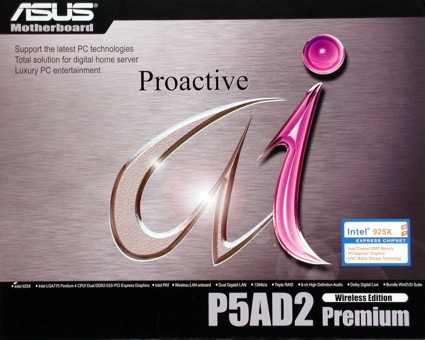Mobo Makers Try Again with Intel's 925X and 915P Chipsets
Asus P5AD2 Premium
BIOS: 1005 Beta 002 (07/13/2004)
The BIOS version supplied with the board caused us some problems: with some GeForce 6800 models, Windows absolutely refused to start in the case of the P5AD2. Moreover we repeatedly experienced the effect that the RAID-BIOS lost the array settings. In addition, the board already cut out unexpectedly when the CPU case temperature reached a tame 66°C.
These teething problems were remedied all by the first update version, which was replaced by a second, faster variant shortly afterwards. With the third update the FSB overclocking reached up to 283 MHz and with the fourth version (1005 Beta 002) Asus also wanted to rectify the problem with premature cutouts. This was sorted out by changing the display by +10°C. The only remaining problem is the problem with crashing when carrying out a DOS boot with an LS120 disk drive.
The special features of the Asus board include an 8-Mbit BIOS and an integrated WLAN module (802.11b/g). An ITE chip offers two additional UltraATA channels and, thanks to the Silicon Image controller, there are 8 SATA ports in total. Asus also offers Firewire ports according to the a and b standards (400/800 MBit/s) and Dual PCI Express Gigabit Ethernet ports. All 775 boards also offer the possibility of operating the DDR2 memory asynchronously with 300 MHz (DDR2-600) - a unique feature at present.
Asus places an additional PCB layer on the underside of the board. This feature called "Stack Cool" is intended to distribute the dissipated heat of the voltage regulators evenly and thus improve the stability and life span of the components. While we can confirm that this measure has a slight temperature-lowering effect, the heat sink placed on the voltage regulators appears to be less beneficial, as the remaining voltage stabilizers are uniformly subjected to high loads and are not cooled.
The back panel is well equipped.
Asus a two-chip Firewire 1394 solution.
Get Tom's Hardware's best news and in-depth reviews, straight to your inbox.

Patrick Schmid was the editor-in-chief for Tom's Hardware from 2005 to 2006. He wrote numerous articles on a wide range of hardware topics, including storage, CPUs, and system builds.



